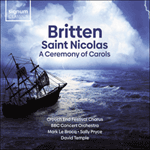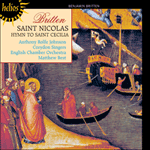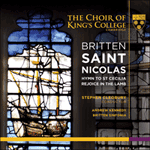
Welcome to Hyperion Records, an independent British classical label devoted to presenting high-quality recordings of music of all styles and from all periods from the twelfth century to the twenty-first.
Hyperion offers both CDs, and downloads in a number of formats. The site is also available in several languages.
Please use the dropdown buttons to set your preferred options, or use the checkbox to accept the defaults.

Methodius, no doubt anxious to add perfume to the odour of his hero’s sanctity, was at pains to emphasize the incidence of the number three (the holy number) in Nicolas’s legend. By his gift of three bags of gold to three impoverished girls to save them from prostitution he became patron of unmarried girls, and also, coincidentally, of pawnbrokers, for this story is the origin of the three gold balls that are the pawnbrokers’ insignia. He is credited with saving three men from an unjust death; and the rescue of three drowning sailors off the coast of Turkey made him patron saint of sailors. But not the least of his holy works is the one which made Nicolas the protector of children and most beloved of saints—the restoration to life of three little boys pickled in brine by a vicious butcher in time of famine. In addition to these diverse patronages Nicolas is also the protector of merchants, perfumiers, and apothecaries.
During the eleventh and twelfth centuries his cult was particularly strong in England. Anselm and Godric composed prayers to him, and Godric set his to music. Though the cult of saints went into decline following the Reformation, Nicolas’s survived and he became transmogrified by his association with Christmas and the giving of presents to deserving children into the universal Santa Claus.
Nicolas’s association with boys and merchants made him the perfect choice of subject when, in 1948, Lancing College celebrated its centenary and asked Benjamin Britten to write something specially for the occasion. Peter Pears, a one-time pupil of the College, probably had something to do with securing the commission. Eric Crozier, already associated with Britten as producer of The Rape of Lucretia and librettist of Albert Herring, furnished the text of what turned out to be the composer’s first important work for children’s voices. Crozier selected eight episodes from Nicolas’s story—his prodigious piety at birth, his call to the holy life, his saving of the sailors on his way to Palestine, his election to the bishopric of Myra, his imprisonment under Diocletian, his restoration to life of the three boys and other marvellous deeds, and finally his tranquil joy in the face of death. And Britten, no doubt aware of Nicolas’s kindness to unmarried girls, drew on the services of a girls’ choir (albeit modestly distanced) to augment the boys’ voices. At the first performance, which actually took place at the Aldeburgh Festival and not at Lancing, the Lancing boys were joined by choirs from Ardingly, St Michael’s and Hurstpierpoint Schools. The solo tenor part representing Nicolas was sung, naturally enough, by Pears. The instrumental accompaniment, designed to remain within the compass of what a school could provide and accomplished players comfortably manage, consists of piano duet, strings, percussion (not immediately used) and organ.
Peter Evans, in his book about the composer, has made a comprehensive analysis of Saint Nicolas, drawing our attention to the many ingenious devices by which Britten knits together what superficially appear to be simple, sometimes naive, ideas, making out of them a pièce d’occasion which E M Forster described as ‘one of those triumphs outside the rules of art’.
Is everything as faultless, though, as Forster’s tribute might suggest? The fugal section of the fifth movement could be thought over-extended and rather limp, and though the incorporation of a well-known hymn, ‘The Old Hundredth’ (‘All people that on earth do dwell’), has a distinguished pedigree going back to the cantatas of Bach and gives the audience something to get its teeth into, it comes with a bit of a jolt. On the credit side the storm music of the fourth movement, achieved by relatively simple means, is typical Britten and highly effective, and the choral setting of the Nunc dimittis in counterpoint to the tenor solo as Nicolas looks forward to meeting God is inspired. Here the music modulates with effortless ingenuity and might have seemed slick had it not been of such transparent loveliness. But the magic is disappointingly diffused by the appearance of a second ‘chorale’, the hymn ‘God moves in a mysterious way’. Despite the gloss Britten has put upon its mundane harmonies, this, coming as the climax to the work, seriously threatens the emotional climate created earlier.
from notes by Kenneth Dommett © 1988
Méthode, sans doute soucieux de rajouter à l’odeur de sainteté de son héros, s’ingénia à renforcer la fréquence du chiffre 3 (le chiffre saint) dans la légende de Nicolas. En donnant trois sacs d’or à trois jeunes filles très pauvres pour les sauver de la prostitution, Nicolas devint le patron des jeunes filles célibataires et aussi, fortuitement, des prêteurs sur gages (cette histoire est à l’origine des trois balles d’or qui sont l’emblème de cette corporation). On dit qu’il aurait également sauvé trois hommes d’une mort injuste; et avoir secouru trois marins en train de se noyer au large de la côte turque lui valut de devenir le saint patron des marins. Mais son œuvre sainte entre toutes, celle qui fit de lui le protecteur des enfants et le plus aimé des saints, fut la résurrection de trois garçonnets saumurés par un cruel boucher, en temps de famine. Saint Nicolas est, par ailleurs, le protecteur des marchands, des parfumeurs et des apothicaires.
Aux XIe et XIIe siècles, son culte fut particulièrement vivace en Angleterre. Anselm et Godric lui écrivirent des prières (Godric mit même la sienne en musique). Le culte des saints eut beau décliner après la Réforme, celui-ci subsista et Nicolas, métamorphosé par son lien avec Noël et par sa distribution de cadeaux aux enfants méritants, devint l’universel Santa Claus.
Associé aux jeunes garçons et aux marcharnds, Nicolas fit un thème tout trouvé pour la pièce que Benjamin Britten eut à écrire en 1948 pour le centenaire du Lancing College—une commande à laquelle Peter Pears, ancien élève du collège, ne fut certainement pas étranger. Eric Crozier, qui avait déjà travaillé avec Britten comme producteur (The Rape of Lucretia) et comme librettiste (Albert Herring), fournit le texte de ce qui s’avéra être la première grande œuvre brittenienne pour des voix d’enfants. Crozier sélectionna huit épisodes de la vie de Nicolas: sa prodigieuse piété, dès sa naissance; son appel à la vie sainte; son sauvetage des marins, alors qu’il se rendait en Palestine; son élection à l’épiscopat de Myra; son emprisonnement sous Dioclétien; sa résurrection des trois garçonnets; diverses autres actions merveilleuses et, enfin, sa joie tranquille face à la mort. Sachant certainement la bonté du saint envers les jeunes filles, Britten recourut à un chœur de filles (quoique modestement tenu à distance) pour augmenter les voix de garçons. À la création de l’œuvre, qui se déroula non à Lancing mais au festival d’Aldeburgh, les garçons de Lancing furent rejoints par les chœurs des écoles de Ardingly, St Michael’s et Hurstpierpoint. La partie de ténor solo incarnant Nicolas fut assurée, assez logiquement, par Pears. L’accompagnement instrumental, conçu pour ne pas dépasser ce qu’une école pouvait fournir, et ce que des exécutants accomplis pouvaient réussir sans peine, est le suivant: duo pianistique, cordes, percussion (pas utilisée d’emblée) et orgue.
Dans son ouvrage consacré à Britten, Peter Evans se livre à une analyse détaillée de Saint Nicolas et attire notre attention sur les procédés ingénieux qui permirent au compositeur de nouer ensemble des idées apparemment simples, voire naïves, et d’en faire une pièce d’occasion décrite par E. M. Forster comme «l’un de ces triomphes en dehors des règles de l’art».
Pour autant, tout est-il aussi impeccable que pourrait le laisser entendre l’hommage de Forster? On peut trouver la section fuguée du cinquième mouvement trop longue, mollasse; et l’on est un peu pris de court malgré l’incorporation d’une hymne célèbre, «The Old Hundredth» («All people that on earth do dwell»), qui s’inscrit dans une prestigieuse lignée remontant aux cantates de Bach et mobilise le public. En revanche, deux épisodes sont à porter à l’actif de cette œuvre: la musique tempétueuse du quatrième mouvement, réalisée avec des moyens relativement simples, bien de Britten et très efficace; et la version chorale, inspirée, du Nunc dimittis, en contrepoint au solo de ténor, quand Nicolas grille de rencontrer Dieu. Ici, la musique module avec une ingéniosité remarquable d’aisance et aurait pu paraître doucereuse si elle n’avait été d’un tel charme limpide. Mais cette magie, hélas, s’étiole à l’apparition d’un second «choral», «God moves in a mysterious way». Malgré l’éclat que Britten a pu donner à ses harmonies banales, cette hymne, qui survient comme l’apogée de l’œuvre, menace sérieusement le climat émotionnel créé auparavant.
extrait des notes rédigées par Kenneth Dommett © 1988
Français: Hypérion
Methodius, der zweifellos auf, eine parfümierte Version der Heiligkeit seines Helden aus war, strengte sich an, das Vorkommen der Zahl drei (der heiligen Zahl) in der Nikolauslegende zu betonen. Durch seine Gabe von drei Beuteln Gold an drei arme Mädchen, um sie vor der Prostitution zu bewahren, wurde er gleichzeitig der Schutzheilige unverheirateter Mädchen und der Pfandleiher, denn diese Geschichte ist der Ursprung der drei goldenen Kugeln in ihrem Zunftschild. Er soll drei Männer vor einem ungerechten Tode bewahrt haben, und die Rettung von drei Matrosen vor dem Ertrinken an der türkischen Küste machte ihn zum Schutzpatron der Seefahrer. Aber eine seiner bemerkenswertesten Heiligtaten machte Nikolaus zum Schutzheiligen der Kinder und beliebtesten Heiligen—die Auferweckung von drei Knaben, die ein grausamer Metzger in einer Zeit der Hungersnot getötet und eingepökelt hatte. Außerdem ist Nikolaus auch Schirmherr der Kaufleute, Parfümeure und Apotheker.
Im 11. und 12. Jahrhundert war sein Kult in England besonders stark. Anselm und Godric verfassten Gebete für ihn, und Godric setze seines in Musik. Obwohl der Heiligenkult nach der Reformation nachließ, überlebte Nikolaus und wurde durch seine Assoziation mit Weihnachten und Geschenken an brave Kinder in den universellen Weihnachtsmann umgemodelt.
Nikolaus’ Verbindung mit Knaben und Kaufleuten machte ihn zum perfekten Sujet als das Lancing College 1948 sein hundertjähriges Jubiläum feierte und Benjamin Britten gebeten wurde, etwas zu diesem Anlass zu schreiben. Peter Pears, der seinerzeit ein Schüler in diesem College war, spielte wohl eine Rolle dabei, ihm diesen Auftrag zu sichern. Eric Crozier, der bereits als Regisseur von The Rape of Lucretia und Librettist von Albert Herring mit Britten assoziiert wear, lieferte den Text für das erste Werk des Komponisten für Kinderstimmen. Crozier wählte acht Episoden aus der Geschichte von Nikolaus—seine erstaunliche Frömmigkeit von Geburt an, seine Berufung zum geistlichen Leben, seine Rettung der Seeleute auf dem Weg nach Palästina, seine Wahl zum Bischof von Myra, seine Verhaftung unter Diokletian, seine Wiederbelebung der drei Knaben und andere Wundertaten und Zuletzt seine stille Freude im Angesicht des Todes. Und Britten, der sich zweifellos Nikolaus’ Güte gegenüber unverheirateten Mädchen bewusst war, setzte einen Mädchenchor (wenn auch in geziemendem Abstand) zur Verstärkung der Knabenstimmen ein. In der Uraufführung, die allerdings auf dem Aldeburgh Festival stattfand und nicht in Lancing, wurden die Knaben aus Lancing durch Chöre aus den Schulen von Ardingly, St. Michael’s und Hurstpierpoint verstärkt. Die Solotenorpartie, die Nikolaus repräsentiert, wurde natürlich von Peter Pears gesungen. Die Instrumentalbegleitung, die so angelegt war, dass sie innerhalb der Möglichkeiten blieb, die einer Schule zur Verfügung standen und die versierte Spieler sicher bewältigen konnten, besteht aus Klavierduett, Streichern, Schlagzeug (das nicht unmittelbar verwendet wird) und Orgel.
Peter Evans bietet in seinem Buch über den Komponisten eine gründliche Analyse von Saint Nicolas, und macht uns besonders auf die vielen einfallsreichen Mittel aufmerksam, durch die Britten die oberflächlich betrachtet schlichten, manchmal naiven Ideen verwebt und sie in ein Gelegenheitsstück verwandelt, das E. M. Forster als „einen der Triumphe außerhalb der Regeln der Kunst“ bezeichnet.
Ist aber alles so makellos, wie Forsters Tribut anzudeuten scheint? Der Fugenabschnitt des fünften Satzes könnte als überspannt und eher schwach angesehen werden, und obwohl die Aufnahme einer wohlbekannten Hymne, „The Old Hundredth“ (dichterische Fassung des 100. Psalms „All people that on earth do dwell“/„Alle, die auf Erden leben“) einer langen Tradition folgt, die auf die Kantaten Bachs zurück geht, und dem Publikum etwas Solides zu verdauen gibt, ist sie etwas abrupt. Auf der Plusseite finden sich die typisch brittensche und äußerst wirkungsvolle Sturmmusik des vierten Satzes, die durch relativ schlichte Mittel erreicht wird, und der Chorsatz des Nunc dimittis im Kontrapunkt zum Tenorsolo für Nikolaus’ Vorfreude auf die Begegnung mit Gott ist inspiriert. Die Musik moduliert hier mit müheloser Raffinesse und könnte als zu glatt erscheinen, wenn sie nicht von solch transparenter Anmut erfüllt wäre. Aber der Zauber wird leider durch einen zweiten „Choral“, die Hymne „God moves in a mysterious way“ („Die Wege des Herrn sind unergründlich“) gebrochen. Trotz des Glanzes, den Britten seinen banalen Harmonien verleiht, gefährdet diese Schluss-Steigerung des Werkes das früher geschaffene emotionale Klima des Werkes.
aus dem Begleittext von Kenneth Dommett © 1988
Deutsch: Renate Wendel
 Britten: A Ceremony of Carols & Saint Nicolas Britten: A Ceremony of Carols & Saint NicolasTwo Benjamin Britten classics in performances which must be as close to the composer's intentions as any.» More |
 Britten: Saint Nicolas & Hymn to Saint Cecilia Britten: Saint Nicolas & Hymn to Saint Cecilia‘A very fine recording’ (Gramophone) ‘A fresh and atmospheric account of Britten's colourful cantata’ (The Penguin Guide to Compact Discs)» More |
 Britten: Saint Nicolas & other choral works Britten: Saint Nicolas & other choral worksA new recording of Britten's enchanting choral masterpiece 'Saint Nicolas' celebrates 100 years since the composer's birth.» More |

